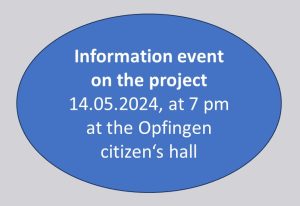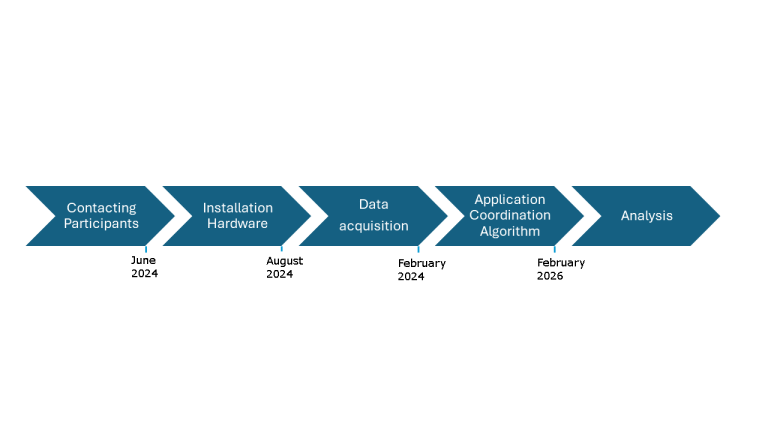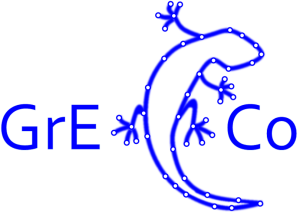
Smart Grid Opfingen
The expansion of renewable energies is progressing faster than the expansion of the electricity grid. We are striving to use intelligent coordination between electricity generation and consumption in order to relieve the load on the electricity grid.
Table of contents
- What is the aim of the project?
- How will the electricity grid be relieved?
- Who can take part in the project?
- What does the participation in the project mean?
- What is the timeline of the project?
- How you can take part in the project
- FAQ

What is the aim of the project?
The energy transition is in full swing and the expansion of renewable energies is gathering pace. In many cities and municipalities, more and more electricity is being generated by private households. This means that the electricity no longer has to come from large power plants, but can be used within the cities and municipalities. However, it is not only electricity production that is changing as part of the energy transition; the demand for electricity is changing significantly already. Cars with combustion engines are being replaced by electric cars and the heating transition is also relying heavily on electric heating technologies, e.g. heat pumps. We therefore expect a very high increase in demand for the grid area of Freiburg by 2040! The higher the power flows in the electricity grid, the greater the number and capacity of power lines and other equipment is needed. This represents a major challenge for all grid operators. Unfortunately, getting the grid fit for the energy transition will take longer than the expansion of renewable energies and large electricity consumers such as heat pumps and electric cars. Many ideas and approaches already exist to counteract this problem. We at badenovaNETZE, your electricity grid operator for the region, want to drive forward the energy transition as efficiently and sustainably as possible, while always taking the interests of consumers into account. With the help of the “Smart Grid Opfingen” project, we would like to demonstrate a new way of reducing the load on the electricity grid by intelligently coordinating electricity generation and consumption. The electricity that is generated in Opfingen should also be used in Opfingen. The aim is to show that less grid expansion is required and that transmission losses are lower overall. Reduced grid expansion leads to lower grid fees for consumers, lower resource consumption and fewer construction sites in the municipalities.
The aim of the project is to develop a system that is as efficient, secure and innovative, to support us in the energy transition!
How will the electricity grid be relieved?
We will install modern measurement and control technology at all participants homes. If you have a photovoltaic system or controllable consumers (a battery storage unit, a heat pump and/or an e-charging station), these will be connected to a network. Using modern measurement technology, electricity consumption and production can be recorded “live”. This allows to determine the current load on the electricity grid and forecast the future load. With the help of the installed energy management system, it is possible to adjust the draw or feed-in power of the various components in such a way that extremely high loads on the electricity grid are avoided. The control system only intervenes if a bottleneck is expected in the grid. This bottleneck is prevented by ensuring that the controllable loads do not all draw their full power from the grid at the same time and that the PV feed-in is used as much as possible within the neighborhood. A grid bottleneck can occur, for example, due to the capacity limit of a power line or a transformer station. The electricity grid in Opfingen is very stable. No bottlenecks are expected here in the next years. To test the system for the future, we simulate a bottleneck on selected days by assuming that the capacity limits are lower than they actually are.

The illustration shows the exemplary structure of the Smart Grid Opfingen. Firstly, the electricity grid is equipped with modern measurement technology. This will allow the power lines and the transformer station to be monitored. In addition, energy management systems (“OLI box”) will be installed in the households. The live data is sent to the coordination algorithm via the OLI box. This algorithm uses the measurement data and forecasts to determine whether and where interventions are necessary to reduce the load on the electricity grid.
Electricity production and consumption are synchronized with each other, so that the electricity produced in the neighborhood is also consumed there!
Who can take part in the project?
All households located in the marked area can participate in the Smart Grid Opfingen project. It does not matter whether you have a photovoltaic system, heat pump or similar. All participants are important and support the project. If you are interested in being part of the project, your electricity meter will be examined by our technicians and an energy management system will be installed. This involves inspecting whether or not an energy management system can be integrated into the existing home network. Here is a detailed list of the addresses that can take part in the project:
Krautgärten 1-22
Rosenweg 1-7
Nelkenweg 1-8
Unterdorf 52-74
Am Sportpl. 16a-46 (ausgenommen 17,18)
Tulpenstraße 1-30
Am Neugraben 23, 25, 27, 29, 33, 35, 37, 39-92

Anyone in the marked area can take part, regardless of the devices installed in the household!
What does participation in the project mean?
As a first step, a technician will check whether your home electrics allow you to participate. In most cases, this should not be a problem. After a successful initial check, a service technician will install the control and measurement technology in consultation with you or, if necessary, the property management company. These installations will be carried out at the electricity meter (usually in the cellar), therefore they won’t be noticeable in the living rooms. In this step, all controllable consumers and, if applicable, the PV system are brought together in an energy management system. This also includes the gateway (communication technology) to send and receive the data to and from the coordination algorithm. The duration of the field test is 1.5 years. After the hardware has been installed, measurement data is recorded for six months in order to adapt the coordination algorithm to the grid area. This is followed by the one-year test phase. A grid bottleneck is simulated on a few days a year. On one such day, the coordination algorithm must eliminate a grid bottleneck. This is done by reducing the load of controllable consumers (i.e. they operate at reduced power for a short time). However, the well-being of the participants is always considered.
With an app, you can see live how high the load is on the electricity grid or at home. You can see transparently how high your electricity consumption is and also see how electricity consumption increases when the washing machine is running, for example. By taking part, you are actively supporting the progress of science and the energy transition. A lot of research is currently being carried out to determine how the energy transition can be realized as quickly as possible while keeping costs to a minimum. Energy communities and demand-side management, such as in the Smart Grid Opfingen project, are leading the way. The Smart Grid Opfingen project therefore offers great potential for shaping our future energy system.
As an expense allowance, all participating households will receive a 50 € voucher for Edeka.

An energy management system is installed at your premises free of charge. You are then part of the project for 1.5 years, in which a grid bottleneck situations are simulated on a few days a year and solved using our control algorithm.
What is the timeline of the project?

All participants will be recruited for the project by June 2024.We use various communication channels to inform as many participants as possible. To this end, the project was presented by badenovaNETZE at the Opfingen local council meeting on 05.02.2024. Furthermore, an information event will be held for all interested parties to clarify any questions on the 14.05.2024 in the townhall of Opfingen. For all interested households, we will check whether the technical conditions allow a participation in the project. If this is the case, a participation contract will be concluded with each household. After this an energy management system will be installed by badenovaNETZTE and OLI Systems by August 2024. All you have to do is make an appointment with us. In the following six months until February 2025, data will be collected to adapt the system perfectly to your neighborhood. The field test starts in March 2025! For one year, the system will solve fictitious bottlenecks in the electricity grid on selected days of the year. The field test will run for one year until February 2026, after which the project will be evaluated. The recorded measurement data will be analyzed and the effect of the system assessed. Later on we will share the results with all participants.
How you can take part in the project
Send us an e-mail with your name and address to smart-grid-opfingen@badenovanetze.de. We will contact you immediately, present the contract and discuss all further steps with you.
Thank you for your interest in participating!
FAQ:
By participating in the project, you are actively supporting the energy transition. Testing energy communities could benefit everyone in the future and possibly reduces the price of electricity. You will also receive a free energy management system and can use an app to precisely analyze your electricity consumption and possibly identify hidden energy guzzlers. Unfortunately, we cannot offer any financial compensation for participating in the project. As an expense allowance, all participating households will receive a 50 € voucher for Edeka.
Participation is open to every household in the marked neighborhood in Opfingen, regardless of the electricity provider.
Yes, every household can participate regardless of the technical equipment. Households without controllable devices support the system by providing data on the consumption behaviour of the household.
No, the output of your devices will not be significantly reduced over a longer period of time. The aim is to optimize the algorithm in such a way that, for example, the heat buffer of the heating system is utilized and you do not notice the intervention. This means that you won’t have to freeze or stand in front of an empty electric car even during interventions. It should also be emphasized that the algorithm will only interact with your energy management system on a few days a year.
The more households that take part, the better. We have set ourselves a target of 20 – 30 households, but we are happy to surpass this number.
Your storage system will not feed electricity into the grid during the field test. The electricity from your storage system will be used exclusively for your household.
In apartment buildings, all owners must agree to participate in the project, as installations are carried out in common areas (in the cellar) for participation. Unfortunately, participation is not possible without the consent of the homeowners association. If different tenants live in the apartment building, they must only give their consent if their household will be participating in the project. It is possible that only individual households in an apartment building will participate in the project.
Any tenant can also take part in the project, but this requires the consent of the landlord or the homeowners association (in the case of an apartment building).

